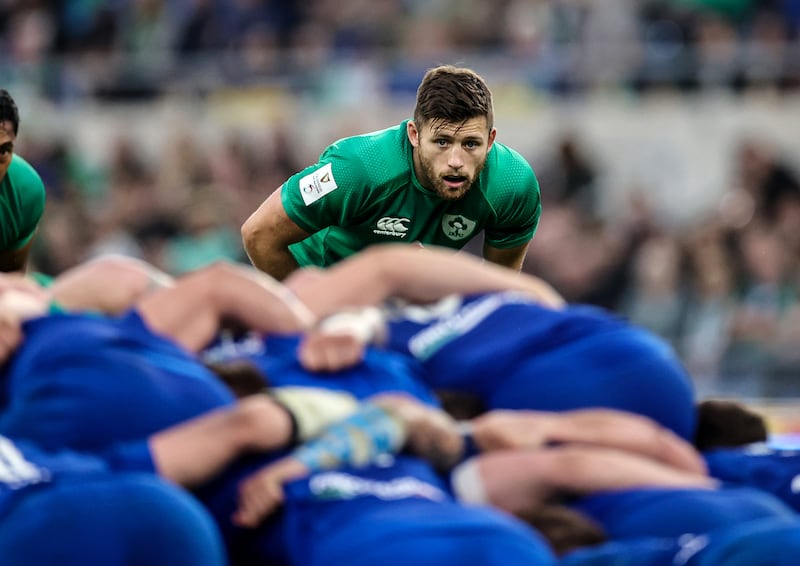It’s rugby’s version of an arranged marriage, when a halfback combination comes together to start a game as a pair for the first time. Craig Casey and Ross Byrne were thrust into that situation at the Stadio Olimpico, charged with being Ireland’s primary game managers in the absence of Jamison Gibson-Park and Johnny Sexton.
Comparisons may be odious, but they are an integral part of sport. Players are viewed through the prism of performance and the natural order is based on the evidence. To be someone is about not trying to be someone else. The challenge is to be able to let talent breathe all the while doing what’s required, even if it is with a different slant or accent but with a net result that it is the team that benefits.
Casey can’t be Gibson-Park no matter how much people might wish, Byrne cannot clone Sexton’s game, he has a separate identity as a rugby player. But for all that, there is a requirement to be able to effectively run a game. In an ideal world when the principals are missing, those that understudy don’t miss a beat.
There were further complications in that Stuart McCloskey and Bundee Aki were also ‘first timers’ as a combination, with the Connacht man in an unfamiliar role of outside centre, having not played much rugby of late.
There was a harum-scarum, breathless quality to the match at the Stade Olimpico, a game that lacked definition
Repping in training is light years removed from the blood and thunder of Test match rugby where the requirement to make hair-trigger decisions is commonplace. Cohesion in unit skills is based on familiarity, good communication and trust, qualities that take time to nurture but must be tempered in the match environment.
There was a harum-scarum, breathless quality to the match at the Stade Olimpico, a game that lacked definition in an orthodox sense and instead burst into life through handling errors and turnovers. It made for giddy entertainment unless you were a defence coach.
James Lowe’s one-handed slam dunk didn’t cut the mustard, but Ireland had the game’s first try less than 60 seconds later; Casey, Aki and Lowe combining down the short side off a ruck to send captain James Ryan in for a try.
It was a bright start but a succession of errors and rash decisions from the restart allowed Italy to energise the crowd with a sharply taken try by Stephen Varney. Ireland needed to put a bit of shape on the game.
Byrne kicked long when clearing, which seemed a policy decision, but it did feed Italy and they made slicing runs through the midfield and got great traction on the edges in eating up the metres. The Irish pack struggled to get consistent go-forward ball which had a knock-on effect for the halfbacks, who were trying to play off slow, generally static possession.

At this point they needed to change the picture a little. Speed of thought trumps speed of foot. Gibson-Park is very quick to rucks but it is his ability to take in the panorama, size up where the opportunities lie and pick his passes that allow him to generate tempo in underwriting Ireland’s attacking patterns. It’s a core component.
Casey is very quick to the breakdown but too often Ireland relied on the one-out runners easily identifiable for the Italian defence, who frequently double teamed the carrier and knocked him on his backside. There was very little subterfuge to what Ireland offered in that close carrying game.
The scrumhalf needed to vary the point of attack, alter the shape, chivvy the pack to do his bidding. When Ireland were shut down in terms of momentum, Byrne – his line kicking from penalties was first class – was then tasked with solving the riddle. Trying to play off slow ball carries a significant risk, a fact reinforced by the fact that Pierre Bruno got into the Irish backfield for his intercept try.
There were some moments of clarity, Byrne, McCloskey, Josh van der Flier and Lowe doing the leg work for Aki’s try offering a reminder of what Ireland could do off quick ball. Casey’s high tariff pass to Lowe on penalty advantage was a rushed rather than rash decision but Mack Hansen’s try shortly afterwards negated any blowback; other than it was simply an impatient choice.
The bench made a difference but so did Murray’s governance and reorganisation of the duty list for his pack
Ireland had attacked the short side very effectively in the first half with the halfbacks playing their part and it should also be noted that had the visitors also got over the line several times for what should have been tries. Those additional points would have changed the complexion of the match.
The halfbacks started the second half brightly, Casey’s perfectly weighted box-kick, Byrne’s equally well-judged grubber kick but the Irish pack continued to struggle to make it past the gainline and the breakdown was more a case of rescue and realign. Game management issues resurfaced.
When Italy clambered back to 24-20, Byrne dropped a little deeper, Casey box-kicked further up the pitch before being replaced by Conor Murray. The bench made a difference but so did Murray’s governance and reorganisation of the duty list for his pack.
The halfbacks don’t operate as a separate fiefdom to the rest of the team and are reliant on a platform created but occasionally there’s a need to muddle through, to go off script, read the game and find solutions. That’s what Gibson-Park and Sexton do most of the time.
Casey and Byrne will be wiser after Rome. Will they be better? That’s the challenge going forward but opportunities will be scarce, so they’ll need to be.






